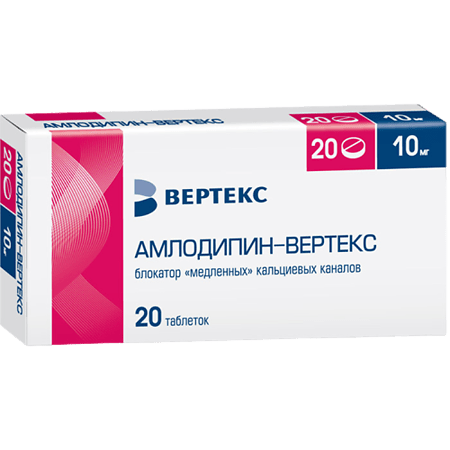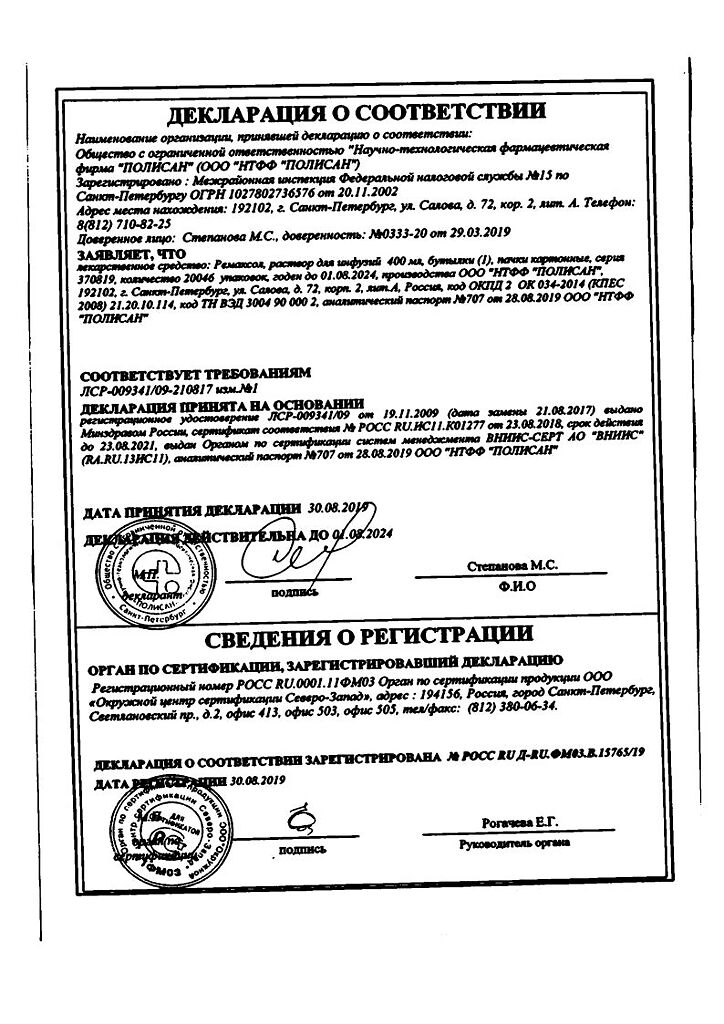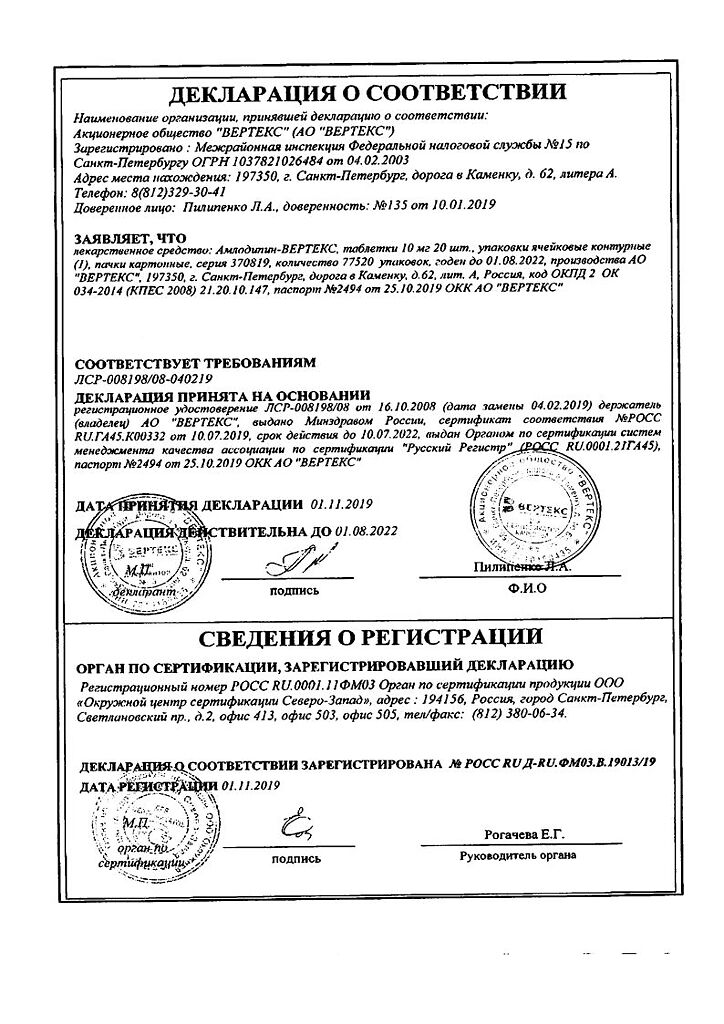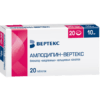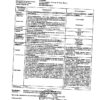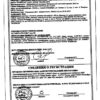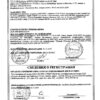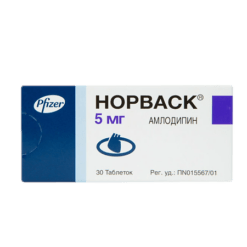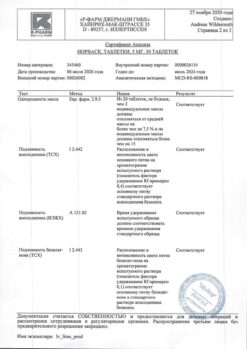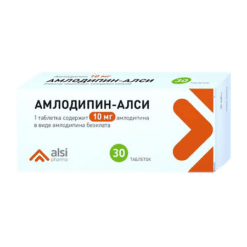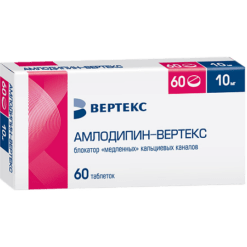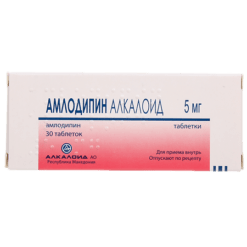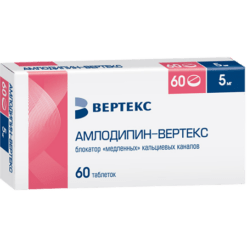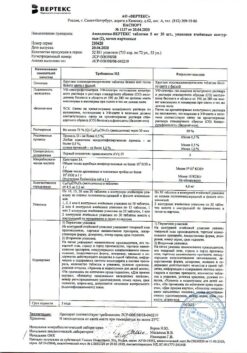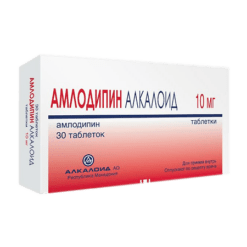No products in the cart.
Amlodipine-Vertex, tablets 10 mg 20 pcs
€2.21 €1.84
Out of stock
(E-mail when Stock is available)
Description
Dihydropyridine derivative is a second generation BMCC with antianginal and hypotensive effects. Binding to the S6 segment of III and IV domains of L-type calcium channel alpha1-subunit, it blocks calcium channels, reduces transmembrane Ca2+ transfer into the cell (more in vascular smooth muscle cells than in cardiomyocytes).
It has hypotensive and antianginal effect. The mechanism of hypotensive action of amlodipine is due to a direct relaxing effect on vascular smooth muscle. Myocardial ischemia is decreased due to dilation of coronary and peripheral arteries and arterioles in unchanged and in ischemic areas of myocardium, decrease of myocardial pressure, decrease of postload, myocardial oxygen demand.
Enhances myocardial oxygen supply in patients with vasospastic angina (Prinzmetal angina); prevents the development of coronary spasm caused by smoking.
In patients with angina a single daily dose increases exercise time, delays the development of another angina attack and S-T segment depression (by 1 mm) on exercise, reduces the frequency of angina attacks and nitroglycerin consumption. It has a long-term dose-dependent hypotensive effect.
The hypotensive effect is due to the direct vasodilating effect on the vascular smooth muscles. In arterial hypertension a single daily dose gives clinically significant lowering of BP during 24 hours (in “lying” and “standing” position).
. In patients with CCC diseases (including coronary atherosclerosis with lesion of one vessel and up to stenosis of 3 or more arteries, atherosclerosis of the carotid arteries), patients who have undergone MI, percutaneous transluminal angioplasty of coronary arteries or patients with angina pectoris, use of amlodipine prevents carotid intima-media thickening, reduces mortality from MI, stroke, transluminal angioplasty, coronary artery bypass grafting; leads to fewer hospitalizations for unstable angina and progression of CHF; reduces the frequency of interventions to restore coronary blood flow.
It does not increase risk of death or complications and lethal outcomes in patients with CHF (III-IV class according to NYHA) during therapy with digoxin, diuretics and ACE inhibitors. In patients with CHF (class III-IV according to NYHA) of non-ischemic etiology when using amlodipine there is a possibility of pulmonary edema. It does not cause sharp decrease of BP, decrease of tolerance to physical load, LV ejection fraction.
Decreases degree of LV myocardial hypertrophy. It does not influence myocardial contractility and conduction, does not cause reflex increase of heart rate, inhibits platelet aggregation, increases glomerular filtration rate, has weak natriuretic action.
In diabetic nephropathy it does not increase severity of microalbuminuria. It does not have adverse effects on metabolism and plasma lipids. Time of the effect – 2-4 hours; duration – 24 hours.
Indications
Indications
Arterial hypertension (monotherapy or in combination with other hypotensive drugs), stable angina pectoris and vasospastic angina pectoris (monotherapy or in combination with other antianginal drugs).
Active ingredient
Active ingredient
Composition
Composition
1 tablet contains:
The active ingredient:
amlodipine besylate (in terms of amlodipine) – 10 mg.
Auxiliary substances:
calcium stearate,
potato starch,
lactose (milk sugar),
magnesium stearate,
microcrystalline cellulose.
How to take, the dosage
How to take, the dosage
Ingestion, regardless of meals.
To treat arterial hypertension and prevent attacks of angina pectoris and vasospastic angina: The initial dose of Amlodipine is 5 mg once daily.
If necessary, the daily dose may be increased to a maximum of 10 mg (once daily).
Interaction
Interaction
Microsomal oxidation inhibitors may increase the plasma concentration of amlodipine, increasing the risk of side effects, and inducers of microsomal liver enzymes may decrease this indicator.
Unlike other DMICs, amlodipine has no clinically significant interaction with nonsteroidal anti-inflammatory drugs, especially with indomethacin. Thiazide and “loop” diuretics, beta-adrenoblockers, verapamil, ACE inhibitors and nitrates enhance antianginal or hypotensive effects of amlodipine. Amiodarone, quinidine, alpha 1-adrenoblockers, antipsychotics (neuroleptics) and isoflurane may increase the hypotensive effect of amlodipine.
Calcium preparations may decrease the effect of BMCC. Co-administration of amlodipine with lithium preparations may increase neurotoxicity of the latter (nausea, vomiting, diarrhea, ataxia, tremor, tinnitus). Amlodipine has no effect on pharmacokinetic parameters of digoxin and warfarin. Cimetidine has no effect on the pharmacokinetics of amlodipine. Antiviral agents (ritonavir) contribute to increased plasma concentrations of PBMCs (including amlodipine).
Special Instructions
Special Instructions
Application in liver function disorders: in patients with hepatic impairment as hypotensive agent Amlodipine is prescribed with caution, in the initial dose of 2.5 mg, as antianginal agent – 5 mg.
Performance in renal insufficiency: there is no need to change the dose in patients with renal insufficiency. In elderly patients: T 1/2 may increase and creatinine clearance (CK) may decrease. No dose changes are required, but closer monitoring of patients is necessary. There is no need to change the dose when concomitant administration with thiazide diuretics, beta-adrenoblockers and angiotensin-converting enzyme inhibitors (ACE).
Amlodipine treatment requires control of body weight and sodium salt intake of patients; appropriate low-salt diet is prescribed. It is necessary to maintain dental hygiene and visit dentist regularly (for prevention of pain, bleeding and gum hyperplasia).
The dosing regimen of Amlodipine in elderly patients is similar to that in patients of other age groups. If the dose is increased, close monitoring of elderly patients is necessary. Although there is no withdrawal syndrome in BMCCs, a gradual dose reduction is recommended before discontinuing treatment. Amlodipine does not affect plasma concentrations of potassium ions, glucose, triglycerides, total cholesterol, low-density lipoproteins, uric acid, creatinine and urea nitrogen. Abrupt withdrawal of the drug should be avoided because of the risk of worsening the course of angina pectoris.
Amlodipine tablets are not recommended in hypertensive crisis. Patients of low body weight, patients of short stature and patients with significant liver dysfunction may require a lower dose. Effect on driving and operating machinery There have been no reports about the effect of Amlodipine on driving or operating machinery. However, drowsiness and Dizziness may occur in some patients, mainly at the beginning of treatment.
When they occur, caution should be exercised when driving motor vehicles and engaging in potentially hazardous activities requiring increased concentration and rapid psychomotor reactions.
Contraindications
Contraindications
Hypersensitivity to amlodipine, other dihydropyridine derivatives, other components of the drug.
Developed arterial hypotension (systolic BP less than 90 mm Hg). Collapse. Cardiogenic shock. Unstable angina pectoris (except for Prinzmetal angina). Severe aortic stenosis. Under 18 years of age (efficacy and safety not established). Lactose intolerance, lactase deficiency or glucose-galactose malabsorption . Pregnancy. Period of lactation. The preparation should be used with caution in case of: liver dysfunction, sinus node weakness syndrome (expressed bradycardia, tachycardia), chronic heart failure of non-ischemic etiology of III-IV functional class according to NYHA classification, aortic stenosis, mitral stenosis, hypertrophic obstructive cardiomyopathy, acute myocardial infarction (and during 1 month after), elderly.
Side effects
Side effects
Cardiovascular system: often – palpitations, peripheral edema (edema of ankles and feet); infrequent – excessive reduction of BP, orthostatic hypotension, vasculitis; rare – development or worsening of chronic heart failure; very rare – arrhythmias (bradycardia, ventricular tachycardia, atrial fibrillation), myocardial infarction, pain in the chest, migraine. The central nervous system: frequently – headache, dizziness, fatigue; infrequently – malaise, fainting, neuropsychic asthenization, hypoesthesia, paresthesia, peripheral neuropathy, tremor, insomnia, emotional lability, unusual dreams, nervousness, depression, anxiety; rarely – seizures, apathy, agitation; very rarely – ataxia, amnesia. Blood system: very rarely – thrombocytopenia, leukopenia, thrombocytopenic purpura. Respiratory system: infrequent – shortness of breath, rhinitis; very rare – cough. Digestive tract: frequent – nausea, abdominal pain; infrequent – vomiting, change of defecation mode (including constipation, flatulence), dyspepsia, diarrhea, anorexia, dry oral mucosa, thirst; rare – gum hyperplasia, increased appetite; very rare – gastritis, pancreatitis, hyperbilirubinemia, jaundice (usually cholestatic), increased activity of “liver” transaminases, hepatitis. Genitourinary system: infrequent – pollakiuria, painful urge to urinate, nycturia, impotence; very rare – dysuria, polyuria. Skin: rare – increased sweating; very rare – cold sticky sweat, xeroderma, alopecia, dermatitis, purpura, skin discoloration. Allergic reactions: infrequent – skin itching, rash, very rare – angioedema, erythema multiforme, urticaria. Musculoskeletal system: infrequent – arthralgia, muscle cramps, arthrosis, myalgia (with long-term use), back pain; rarely – myasthenia. Other: infrequent – alopecia, tinnitus, gynecomastia, weight gain / loss, visual impairment, diplopia, accommodation disorders, xerophthalmia, conjunctivitis, eye pain, perversion of taste, chills, nasal bleeding, increased sweating; rarely – dermatitis; very rare – cold sticky sweat, parosmia, pigmentation disorders of skin, hyperglycemia.
Overdose
Overdose
Symptoms:
pronounced BP decrease with possible development of reflex tachycardia and excessive peripheral vasodilation (risk of severe and persistent arterial hypotension, including with the development of shock and death).
Treatment:
Gastric lavage, administration of activated charcoal (especially in the first 2 hours after overdose), maintenance of cardiovascular system function, control of cardiac and pulmonary function parameters, Trendelenburg posture, control of circulating blood volume and urine output. To restore vascular tone – use vasoconstrictors (if there are no contraindications for their use); to eliminate the effects of calcium channel blockade – intravenous injection of calcium gluconate. Hemodialysis is not effective.
Similarities
Similarities
Additional information
| Shelf life | 3 years. |
|---|---|
| Conditions of storage | Store in a dry, light-protected place at a temperature not exceeding 25 ° C. |
| Manufacturer | Vertex, Russia |
| Medication form | pills |
| Brand | Vertex |
Other forms…
Related products
Buy Amlodipine-Vertex, tablets 10 mg 20 pcs with delivery to USA, UK, Europe and over 120 other countries.

